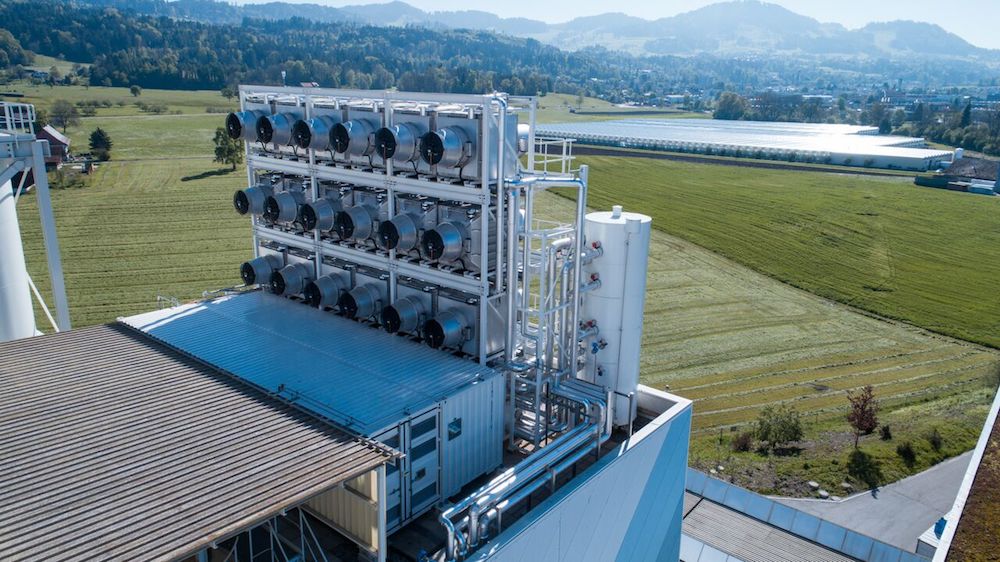Global Warming Gas Can Now Be Extracted from Air and Resold
Climeworks — a spin-off company from the Swiss science, technology, engineering and mathematics university ETH Zurich — built the plant near the village of Hinwil, at a site between a waste incineration plant and a large greenhouse.
Agricultural firm Gebrüder Meier Primanatura, which runs the greenhouse, will use the atmospheric carbon dioxide (CO2) to enhance the growth of lettuce, the company said. The waste incineration plant will provide the heat and renewable electricity needed to run the facility, the company added. [Top 10 Craziest Environmental Ideas]
"The plant will capture 900 tons of CO2 per year," said Valentin Gutknecht, a business development manager at Climeworks. "The plant consists of several CO2 collectors, which are large boxes with filters inside. We blow air through these boxes for several hours, and after the filter is saturated, we heat the box up to 100 degrees [Celsius, or 212 degrees Fahrenheit] to extract the pure CO2 and regenerate the filters."
Carbon dioxide emissions are a main driver of climate change, and current levels of atmospheric CO2 are unprecedented in human history. According to the Intergovernmental Panel on Climate Change, an organization created by the United Nations to evaluate and report on the entire body of climate change science, 10 gigatons of CO2 need to be removed from Earth's atmosphere every year to halt the pace of global warming.
Climeworks founders Christoph Gebald and Jan Wurzbacher first developed the so-called Direct Air Capture (DAC) technology during their studies at ETH Zurich in the late 2000s. At that time, the researchers were able to extract only tiny amounts of CO2, and no one thought the system would ever be commercially viable.
"CO2 capture from air has been a very controversial topic in research for a long time," Gutknecht told Live Science. "There was a belief that the cost can't get down below $600 per ton of CO2 even at the mass scale. But we have managed to break this barrier."
Gebrüder Meier Primanatura estimates that the CO2 from the Hinwil plant will enhance the growth of its lettuce by 20 to 30 percent. Climeworks previously partnered with Audi to research whether the technology could be used to manufacture synthetic fuels from air-captured CO2. [The Reality of Climate Change: 10 Myths Busted]
Get the world’s most fascinating discoveries delivered straight to your inbox.
"The idea is to use excess renewable energy from solar and wind power plants to produce hydrogen and then synthesize it with CO2 to create renewable hydrocarbon fuels such as gasoline and jet fuel," Gutknecht said. "These fuels, once they are combusted in a combustion engine, will release the equal amount of CO2 that has been captured from the atmosphere when the fuel has been produced."
The use of such synthetic fuels made from hydrogen and atmospheric CO2 could one day help to neutralize the carbon footprint of long-haul cargo transportation and aviation, for which electric propulsion does not currently meet the performance needs. Airbus was developing an electric two-seater e-Fan, which in 2014 crossed the English Channel but the project was cancelled in April 2017. Experts say that it will take decades for electric propulsion to be fit for commercial passenger jets. Some carmakers, such as Volvo, are experimenting with hybrid propulsion for heavy-duty trucks, but automotive engineers say that diesel combustion engine will be the number one propulsion technology for this type of vehicles for the foreseeable future.
Climeworks envisions that it could launch 250,000 plants similar to the one in Hinwil by 2025, which the company says would enable the technology to eliminate 1 percent of global fossil fuel emissions. In addition to the captured CO2, innovative new approaches to store, or sequester, carbon dioxide could remove the greenhouse gas from the atmosphere permanently, Gutknecht said. In fact, the company will soon announce a product allowing carbon sequestration, however, it hasn’t provided any details at this stage.
In addition to agriculture and synthetic-fuel manufacturing, Climeworks is targeting fizzy-drink makers, which could use the atmospheric gas in drinks instead of conventional and commercially available CO2, which is a byproduct of ammonia production.
Original article on Live Science.





